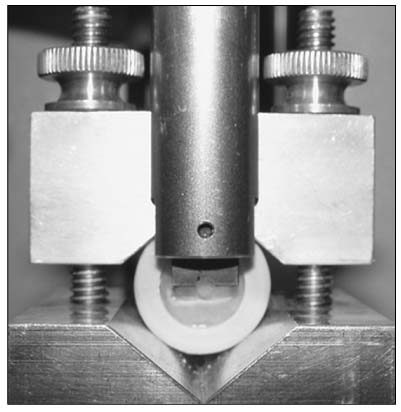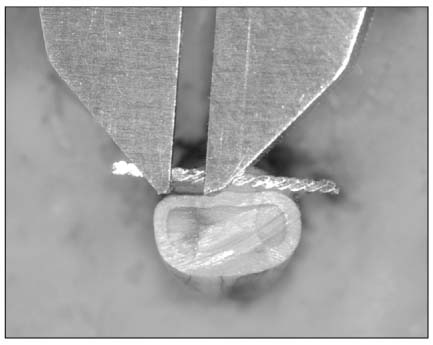Korean J Orthod.
2011 Feb;41(1):51-58. 10.4041/kjod.2011.41.1.51.
Low-shrinking composites. Are they reliable for bonding orthodontic retainers?
- Affiliations
-
- 1Department of Orthodontics, Faculty of Dentistry, Erciyes University, Kayseri, Turkey, and Visiting Professor, King Saud University, Riyadh, Saudi Arabia. tancanuysal@yahoo.com
- 2Department of Orthodontics, Faculty of Dentistry, Erciyes University, Kayseri, Turkey.
- 3Department of Restorative Dental Sciences, King Saud University, College of Dentistry, Riyadh, Saudi Arabia.
- KMID: 1762667
- DOI: http://doi.org/10.4041/kjod.2011.41.1.51
Abstract
OBJECTIVE
To evaluate the shear bond strength (SBS), fracture mode, wire pull out (WPO) resistance and microleakage between low-shrinking and conventional composites used as a lingual retainer adhesive.
METHODS
A total of 120 human mandibular incisor teeth, extracted for periodontal reasons, were collected. Sixty of them were separated into two groups. To determine the SBS, either Transbond-LR (3M-Unitek) or Silorane (3M-Espe) was applied to the lingual surface of the teeth by packing the material into standard cylindrical plastic matrices (Ultradent) to simulate the lingual retainer bonding area. To test WPO resistance, 20 samples were prepared for each composite where the wire was embedded in the composite materialand cured. Then tensile stress was applied until failure of the composite occurred. The remaining 60 teeth were divided into two groups and multi-stranded 0.0215-inch diameter wire was bonded with the same composites. Microleakage was evaluated by the dye penetration method. Statistical analyses were performed by Wilcoxon, Pearson chi-square, and Mann-Whitney-U tests at p < 0.05 level.
RESULTS
The SBS and WPO results were not statistically significant between the two groups. Significant differences were found between the groups in terms of fracture mode (p < 0.001). Greater percentages of the fractures showed mix type failure (85%) for Silorane and adhesive (60%) for Transbond-LR. Microleakage values were lower in low-shrinking composite than the control and this difference was found to be statistically significant (p < 0.001).
CONCLUSIONS
Low-shrinking composite produced sufficient SBS, WPO and microleakage values on the etched enamel surfaces, when used as a lingual retainer composite.
MeSH Terms
Figure
Reference
-
1. Bearn DR. Bonded orthodontic retainers: a review. Am J Orthod Dentofacial Orthop. 1995. 108:207–213.
Article2. Oesterle LJ, Shellhart WC, Henderson S. Enhancing wire-composite bond strength of bonded retainers with wire surface treatment. Am J Orthod Dentofacial Orthop. 2001. 119:625–631.
Article3. Ramoglu SI, Usumez S, Buyukyilmaz T. Accelerated aging effects on surface hardness and roughness of lingual retainer adhesives. Angle Orthod. 2008. 78:140–144.
Article4. Lutz F, Krejci I, Barbakow F. Quality and durability of marginal adaptation in bonded composite restorations. Dent Mater. 1991. 7:107–113.
Article5. Eick JD, Welch FH. Polymerization shrinkage of posterior composite resins and its possible influence on postoperative sensitivity. Quintessence Int. 1986. 17:103–111.6. De Munck J, Van Landuyt K, Peumans M, Poitevin A, Lambrechts P, Braem M, et al. A critical review of the durability of adhesion to tooth tissue: methods and results. J Dent Res. 2005. 84:118–132.
Article7. Breschi L, Mazzoni A, Ruggeri A, Cadenaro M, Di Lenarda R, De Stefano Dorigo E. Dental adhesion review: aging and stability of the bonded interface. Dent Mater. 2008. 24:90–101.
Article8. Hilton TJ. Can modern restorative procedures and materials reliably seal cavities? In vitro investigations. Part 1. Am J Dent. 2002. 15:198–210.9. Hilton TJ. Can modern restorative procedures and materials reliably seal cavities? In vitro investigations. Part 2. Am J Dent. 2002. 15:279–289.10. Irie M, Suzuki K, Watts DC. Marginal gap formation of light-activated restorative materials: effects of immediate setting shrinkage and bond strength. Dent Mater. 2002. 18:203–210.
Article11. Gladwin MA, Bagby MD. Clinical aspects of dental materials: theory, practice, and cases. 2004. Philadelphia, Pa: Lippincott Williams & Wilkins;47–57.12. Guggenberger R, Weinmann W. Exploring beyond methacrylates. Am J Dent. 2000. 13:82D–84D.13. Weinmann W, Thalacker C, Guggenberger R. Siloranes in dental composites. Dent Mater. 2005. 21:68–74.
Article14. Thalacker C, Heumann A, Weinmann W, Guggenberger R, Luchterhandt T, Syrek A. Marginal integrity of class V silorane and methacrylate composite restorations. J Dent Res. 2004. 83:A1364. Spec Iss A.15. Palin WM, Fleming GJ, Nathwani H, Burke FJ, Randall RC. In vitro cuspal deflection and microleakage of maxillary premolars restored with novel low-shrink dental composites. Dent Mater. 2005. 21:324–335.
Article16. Gillgrass TJ, Millett DT, Creanor SL, MacKenzie D, Bagg J, Gilmour WH, et al. Fluoride release, microbial inhibition and microleakage pattern of two orthodontic band cements. J Dent. 1999. 27:455–461.
Article17. James JW, Miller BH, English JD, Tadlock LP, Buschang PH. Effects of high-speed curing devices on shear bond strength and microleakage of orthodontic brackets. Am J Orthod Dentofacial Orthop. 2003. 123:555–561.
Article18. Baysal A, Uysal T, Ulker M, Usumez S. Effects of high-intensity curing lights on microleakage under bonded lingual retainers. Angle Orthod. 2008. 78:1084–1088.
Article19. Uysal T, Ulker M, Baysal A, Usumez S. Different lingual retainer composites and the microleakage between enamel-composite and wire-composite interfaces. Angle Orthod. 2008. 78:941–946.
Article20. Uysal T, Baysal A, Usumez S, Ulker M. Microleakage between composite/wire and composite/enamel interfaces of flexible spiral wire retainers. Part 1: a comparison of three composites. Eur J Orthod. 2009. 31:647–651.
Article21. Uysal T, Ulker M, Baysal A, Usumez S. Microleakage between composite-wire and composite-enamel interfaces of flexible spiral wire retainers. Part 2: comparison of amorphous calcium phosphate-containing adhesive with conventional lingual retainer composite. Eur J Orthod. 2009. 31:652–657.
Article22. Ulker M, Uysal T, Ramoglu SI, Ertas H. Microleakage under orthodontic brackets using high-intensity curing lights. Angle Orthod. 2009. 79:144–149.
Article23. Uysal T, Ulker M, Ramoglu SI, Ertas H. Microleakage under metallic and ceramic brackets bonded with orthodontic self-etching primer systems. Angle Orthod. 2008. 78:1089–1094.
Article24. Bearn DR, McCabe JF, Gordon PH, Aird JC. Bonded orthodontic retainers: the wire-composite interface. Am J Orthod Dentofacial Orthop. 1997. 111:67–74.
Article25. Taylor MJ, Lynch E. Microleakage. J Dent. 1992. 20:3–10.
Article26. Alani AH, Toh CG. Detection of microleakage around dental restorations: a review. Oper Dent. 1997. 22:173–185.27. Reynolds IR. A review of direct orthodontic bonding. Br J Orthod. 1975. 2:171–178.
Article28. Artun J. Caries and periodontal reactions associated with long-term use of different types of bonded lingual retainers. Am J Orthod. 1984. 86:112–118.
Article29. Oliver RG. The effect of different methods of bracket removal on the amount of residual adhesive. Am J Orthod Dentofacial Orthop. 1988. 93:196–200.
Article30. O'Reilly MM, Featherstone JD. Demineralization and remineralization around orthodontic appliances: an in vivo study. Am J Orthod Dentofacial Orthop. 1987. 92:33–40.31. Ogaard B, Rølla G, Arends J. Orthodontic appliances and enamel demineralization part 1 Lesion development. Am J Orthod Dentofacial Orthop. 1988. 94:68–73.
- Full Text Links
- Actions
-
Cited
- CITED
-
- Close
- Share
- Similar articles
-
- A study of shear bond strength of bonded retainer according to the bonding method and type of wires
- Clinical factors affecting the longevity of fixed retainers and the influence of fixed retainers on periodontal health in periodontitis patients: a retrospective study
- Evaluation of the genotoxicity and cytotoxicity in the buccal epithelial cells of patients undergoing orthodontic treatment with three light-cured bonding composites by using micronucleus testing
- Self-adhesion of low-viscosity composites to dentin surface
- The effect of bonded resin surface area on the detachment force of lingual bonded fixed retainers: An in vitro study




